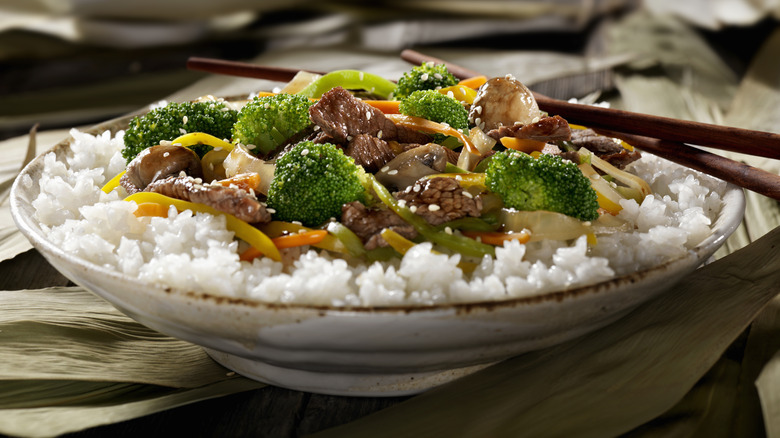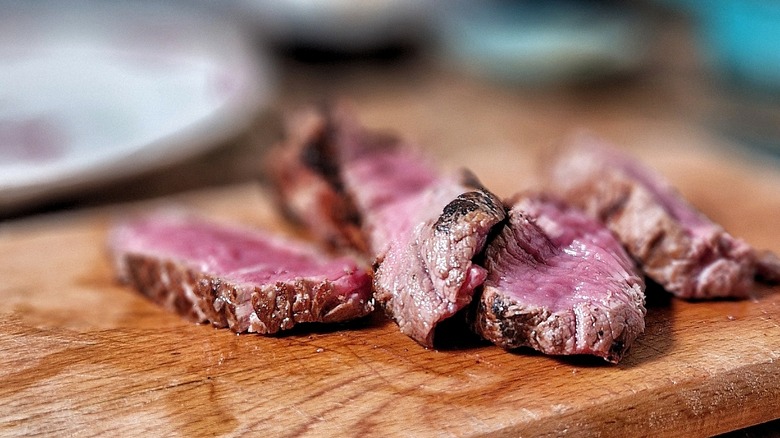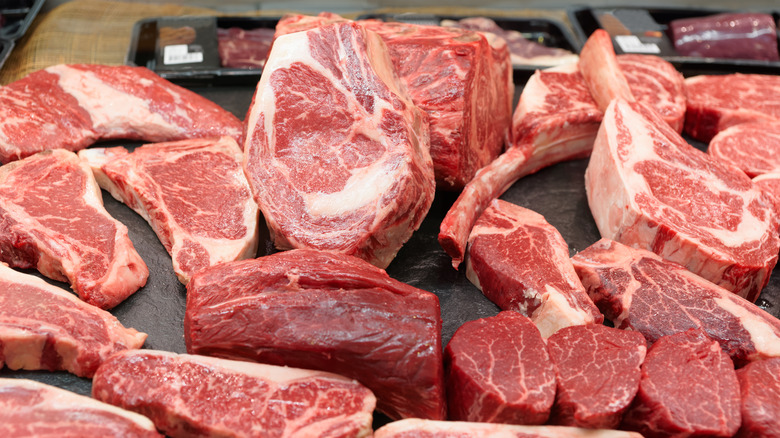The Tender Beef Cuts You Need For Takeout-Worthy Beef And Broccoli
Sometimes it seems like magic is involved in our favorite dishes when dining out. Recreating a restaurant meal can feel daunting, but there are often easy ways to get there, from meal-prepping techniques to buying a restaurant's signature sauce. When it comes to takeout staples, it's hard to beat beef and broccoli, with its tender, seasoned slices of stir-fried meat and just-cooked fresh vegetables.
Fortunately, it's pretty easy to recreate this Chinese-American crowd-pleaser at home. Since the dish consists largely of the two named ingredients (along with a bit of garlic, ginger, and a few spices), it's helpful to get the right beef for the job. Save the T-bones for the grill; there's no need to get fancy here. Ironically, the lean cuts most often used for beef and broccoli, like flank and skirt steaks, aren't particularly tender on their own. Sirloin is nice and lean, but can be too thick for stir fry. However, with the right preparation and recipe, these cuts morph into mouth-watering bites of pure takeout-style joy.
Flank steak is one of the most popular cuts for this dish
If you wander into an Asian specialty market, you'll find thin-sliced meats cut specifically for dishes like ramen, kalbi, or hot pots. But for popular stir fry dishes like beef and broccoli, flank steak is where it's at. This cut of beef comes from the abdominal muscles on the lower rear of a cow's belly, below the loin. It's lean and full of flavor, standing out nicely in dishes featuring strong sauces and umami-rich ingredients.
Because it's not marbled with fat, and the muscle fibers (or grain) are long, flank steak works best when it can be marinated or braised at high heat. This is perfect for beef and broccoli, where the meat is traditionally "velveted," or tenderized with baking soda (and often corn starch), then marinated in soy sauce, oyster sauce, and a rice wine like Shaoxing wine or mirin. In addition, flank steak tends to be a less expensive cut, ideal for restaurants trying to turn a profit, and home cooks aiming to stretch their food budgets.
The steaks are typically a little too thick for stir-fry, so you'll want to butterfly them first. On YouTube, Chef J. Kenji López-Alt demonstrated the best way to prepare lean beef for stir fry: Cut into 2-inch wide strips along the long grains, then slice on a bias (45-degree angle) against the grain into inch-long pieces. This maximizes surface exposure, shortens the grain, and speeds up cooking time.
Alternate cuts for the best beef and broccoli
In general, any cut featuring long muscle fibers and a lower fat content (from the "active" parts of the cow) are going to work well in a beef and broccoli stir fry. Skirt steak comes from inside the abdomen, and also imparts that desirable rich beef flavor, but it's different from flank steak. These are relatively thin already, so you just need to cut it into 1- or 2-inch pieces. Finally, sirloin also works well, though it may need to be sliced in to two or more slender steaks before cutting into individual thin strips. Alternatively, you can take chef Jeremy Pang's advice on his YouTube channel, School of Wok, and dice the meat, flattening it and tenderizing it with a few whacks from a sturdy cleaver. Sirloins tend to have a less intense flavor but are lean cuts and often a good value. As a rule, you'll want to stay away from thicker, juicier cuts of beef like filet mignon or Denver: The higher fat content affects the stir fry. Plus, they tend to be pricey.
Whichever beef cut you choose, remember to cut against the grain and velvet the meat. You'll want to rinse the baking soda off prior to seasoning and cooking, although some recipes omit this step, adding a small amount of bicarbonate of soda to the marinade. Toss the stir fry over steamed rice, and transport yourself instantly to your favorite takeout spot or food court.


